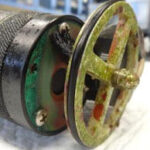
The Tale of Two Wipers
July 25, 2019
The Effects of Drought Intensification on Invertebrate Populations
October 1, 2019Short-Term Variability in Water Quality in Indian Bayou
Project Details
- PRODUCT(S): miniDOT® Logger, miniPAR Logger
- APPLICATION: Coastal / Ocean
- PARAMETER: Diffused Sunlight, Dissolved Oxygen
- LOCATION: Indian Bayou, Pensacola Bay System, North Florida
- ORGANIZATION: Center for Environmental Diagnostics and Bioremediation, University of West Florida
- RECOGNITION: Katherina Smyth and Dr. Jane Caffrey

Case Study Description
Run-off from construction, road maintenance, and other human activities can negatively impact water qualities, even in rural areas with low population density. Indian Bayou, a part of the Pensacola Bay System in north Florida, is sparsely populated, with many unpaved red clay roads. Ditch clearing along these roads, in addition to the widening of a nearby Interstate highway and heavy rain events, has led to increased sediment inputs in near-shore waters.
Katherina Smyth and Dr. Jane Caffrey, researchers from the Center for Environmental Diagnostics and Bioremediation (CEDB) at the University of West Florida (UWF), conducted an eight-week high frequency monitoring project to examine variability in water quality in Indian Bayou.
Within most healthy bodies of water, the presence of vegetation is expected and indeed beneficial. However, the presence of algal blooms is often indicative of an ecological imbalance like an excess of nutrients. Blue-green algae, or cyanobacteria, is a particularly harmful type of algal bloom as it can produce toxins like microcystin. Microcystin and other cyanobacteria toxins can sicken humans and mammals, even proving fatal in sufficient quantities. If left unchecked, algal blooms may create “dead zones” by depleting aquatic oxygen levels and preventing photosynthesis until the water cannot support aquatic flora or fauna like the native Rainbow Trout population.



High Frequency Monitoring with multiple devices
The research team deployed sensors off a dock in Indian Bayou. PME’s miniDOT loggers were used to measure dissolved oxygen content, along with PME’s minPAR logger, which measured diffused sunlight (also known as Photosynthetically Active Radiation or PAR). The team also deployed a conductivity sensor and a light tag sensor.
All sensors were deployed for eight weeks, from May 31, 2018 through July 27, 2018. Each sensor logged data at frequencies ranging from once a second to once every fifteen minutes. Data from the sensors were downloaded on a weekly basis. Discrete water samples were also taken each week: temperature, dissolved oxygen, dissolved inorganic nutrient levels, and chlorophyll a data. The weekly readings were used to address drift in the sensors’ continuous data logging. Data from the sensors was transferred and converted and a graph was generated of each data type.
Daily Variability
Daily variability patterns can be seen in the PAR, light tag, and Dissolved Oxygen graphs.
Effects of rain events on Salinity and turbidity
Rain events can be seen on the Salinity graphs and matched back to the Rain data.
Both PAR and light sensors show higher turbidity following rain events. The more extreme events are seen on June 14 and July 24, 2018.
Human activities combined with rain events
Data showed that, during periods of human activity (widening of a nearby Interstate highway and ditch clearing along the area’s unpaved roads), the highest instances of turbidity in Indian Bayou occurred following rain events. The heavier the rain event was, the more turbidity was logged.

Product Description
PME’s miniDOT logger is a completely submersible instrument for measuring and logging dissolved oxygen content and temperature. The oxygen sensor is an optode that measures dissolved oxygen concentration in water through a fluorescence method. Data are recorded to an internal SD card. Operational functions of the miniDOT, such as time and sample interval, can be set and adjusted using the USB cable.
PME’s miniPAR logger is submersible as well and measures diffused sunlight through water or Photosynthetically Active Radiation (PAR). It contains a tilt sensor to ensure proper orientation as well as a temperature sensor. Data is recorded on an internal SD card. The miniPAR is powered by two AA batteries and can be fitted with an anti-fouling miniWIPER to protect long-term data accuracy.

